Pilgrimage to the Heart
Body / Mind / Spirit
Pilgrimage—The Sacred Art
Journey to the Center of the Heart
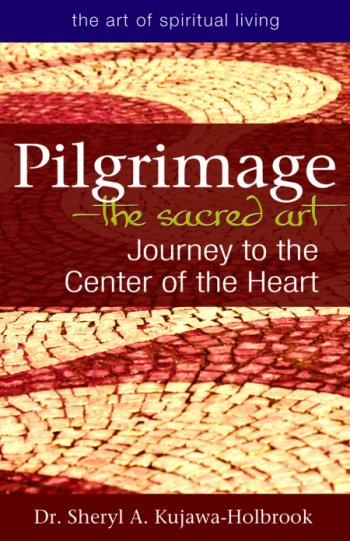
Sheryl A. Kujawa-Holbrook
Skylight Paths
Softcover $16.99 (176pp)
978-1-59473-472-4
Buy: Local Bookstore (Bookshop), Amazon
With few exceptions, we the spiritual take our piety seriously enough to put in a little effort for the cause. Seemingly, we must do more than merely believe in the divine, so each of us develops an individual portfolio of disciplines—prayer, meditation, chanting, tithing, abstaining, or countless other activities—under the belief that such and such will deepen our spiritual chops.
Likewise, the great and powerful religions all play by their own rules. For the most part, Jews do things differently from Christians, Muslims from Buddhists, and so on. Yet there is one esteemed practice that is broadly shared between the faiths: pilgrimage—excursions to shrines, monasteries, and sacred nature sites in search of spiritual nourishment and replenishment.
Why this universal desire to combine the physically demanding with an inward “journey of the heart?” In Pilgrimage (Skylight Paths Publishing, 9781594734724) we find stunningly insightful answers to that question and an arsenal of new material to deepen our own connection to the divine. The aforementioned practices—prayer, meditation, pilgrimage—are not meant to spontaneously make something happen, rather, they are “intended to create openings, to make space, to grab our attention in the midst of our harried lives so that the spirit of the divine, already present, can be made known to us. … The ability to let go of preconceived notions about what should happen or what will happen during a pilgrimage helps a pilgrim remain open to the mystery of what is happening at the moment.”
Mecca, Jerusalem, Santiago de Compostela in Spain, ancient monasteries in Nepal—all these places attract pilgrims, but the real journey, the most important journey, in fact, the “longest journey is the one between the heart and the head.”
Episcopal priest and professor of practical theology Sheryl Kujawa-Holbrook has filled Pilgrimage with hundreds of masterful quotes (including the previous one by Howard Thurman), and her book should be sewn inside backpacks the spiritual world over.
MATT SUTHERLAND (August 31, 2013)
The Tao of Stress
How to Calm, Balance, and Simplify Your Life
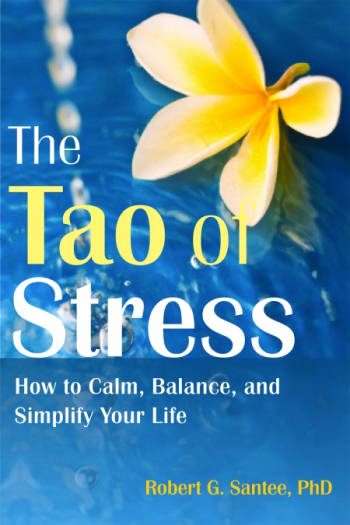
Robert G. Santee
New Harbinger Publications
Softcover $16.95 (192pp)
978-1-60882-780-0
Buy: Local Bookstore (Bookshop), Amazon
Our bodies, science tells us, experience a number of physical and psychological changes when under stress: an increase in heart rate and blood pressure; rapid, shallow breathing; tense muscles; fats released into the bloodstream along with hormones like adrenaline, noradrenaline, and cortisol; and the humoral arm of our immune system ceases working, among other reactions. These responses have been hardwired since prehistoric days when fight-or-flight responses kept us from a saber-toothed demise.
Ordinarily, these intense changes occur and then dissipate under normal stress, but when we experience ongoing stressful episodes, our bodies find it difficult to return to base level.
Ancient texts reveal that Taoists have been developing stress relieving techniques for more than 2,200 years. Taoism’s focus on maintaining a sense of harmony in a constantly changing world points to the importance of Robert Santee’s The Tao of Stress (New Harbinger Publications, 9781608827800), in which he explains three interrelated components for the removal of chronic stress: Simplifying Life, Reducing Desires, and Stilling and Emptying the Mind.
“As this Taoist path incorporates both a mental and physical approach, and it addresses mind, body and environment, it is holistic in nature. To remove chronic stress you need to incorporate both approaches in your life.”
To satisfy the mental aspect, Santee encourages readers to consciously bring a specific problem into awareness, followed by physical activities and practices to train your attention, concentration, and breathing, while learning proper body alignment and relaxation techniques. The goal is to root and center oneself, allowing qi (vital energy and breath) to freely circulate throughout the body.
MATT SUTHERLAND (August 31, 2013)
Contemporary Spirituality for an Evolving World
A Handbook for Conscious Evolution
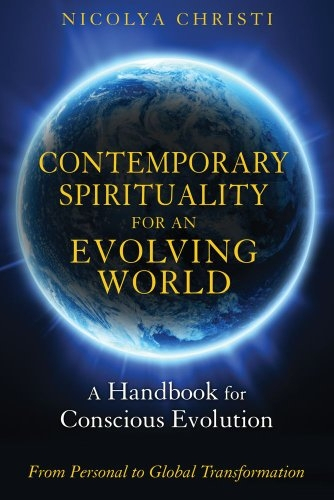
Nicolya Christi
Bear and Company
Softcover $18.00 (304pp)
978-1-59143-166-4
Buy: Local Bookstore (Bookshop), Amazon
If all the diverse elements of humanity—ethnic, regional, spiritual—share one common existential goal, it is surely in the desire to understand consciousness and acquaint ourselves more deeply with who we truly are. We often ask, what is our place in the universe? And, seemingly, there are two paths to pursuing an answer. One is science-minded and logical; the other, in the words of Ervin Laszlo, writing in the foreword to Nicolya Christi’s Contemporary Spirituality for an Evolving World: A Handbook for Conscious Evolution (Bear and Company, 9781591431664), “is the path of direct, lived experience. This is to experience oneness as a fundamental aspect of our life experience.” Laszlo goes on to say that it is also “branded extra-scientific in the modern world and is relegated to the shadowy world of spirituality, religion, esotericism.” Remarkably, the two paths lead to the same realizations: “the insight of fundamental interconnection between our species and the web of life on this planet.”
In the main, to survive and thrive, to maintain scientific coherence and spiritual oneness, humans must develop the “experience of connection, communication, and even communion with the cosmos.” Christi, for her commendable part, offers tools, both psychological and spiritual, to spur conscious and global evolution. She includes an original self-development model based on the “Seven Dark, Seven Light, and Seven Rainbow Arrows” teachings of the First Nations Peoples, wherein attachment, dependency, judgment, expectation, and other Dark Arrows are addressed, followed by the Light Arrows of self-awareness, self-acceptance, self-love, self-actualization, etc. Then she describes how each Arrow contributes to the “psychological evolution, healing, integration, and liberation of the individual and the collective of the twenty-first century.” Of special note is a groundbreaking “fairytale” she created, illustrating an enlightened relationship between self and ego.
MATT SUTHERLAND (August 31, 2013)
Calculating Soul Connections
A Deeper Understanding of Human Relationships
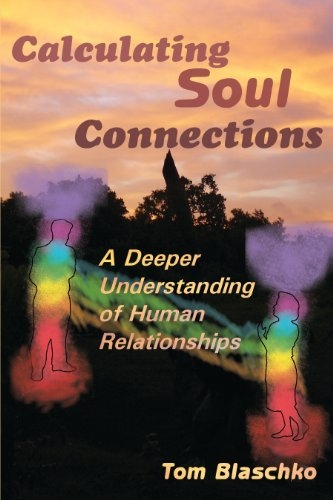
Tom Blaschko
Pine Winds Press
Softcover $18.00 (326pp)
978-0-937663-18-9
Buy: Local Bookstore (Bookshop), Amazon
Don’t mention the word “chakra” in certain company. But if this lightningrod term for the seven parts of the soul doesn’t make your skin crawl, then Calculating Soul Connections (Pine Winds Press, 9780937663189) will likely impress you with its serious-minded attempt to establish the science behind “the structure of the soul and the life force that connects one soul to another.”
Tom Blaschko begins by investigating the concepts of life force (how souls connect), life energy (the energy that powers the soul), and the type of information or messages passed between the chakras. All living things have life force, “you, me, angels, God, and anything else that is alive,” Blaschko writes, and “life force is useful (and probably required) for explaining the ‘strange’ stuff like knowing something is going to happen before it actually does.”
Next, Blaschko details the structure and duties of individual chakras, how the chakras relate within the soul as well as the outside world, and how individual chakras remember experiences. This is where readers will get a feel for his math and science background, as this section features numerous mathematical equations.
Parts three and four pinpoint the connection between individual souls, how and why those connections may vary, and, finally, the soulbody connection and details of the interaction between souls. Just how successful Blaschko is with theorems and explanations, is, of course, impossible to gauge—until words like soul and chakra expand the company they keep.
MATT SUTHERLAND (August 31, 2013)
Emanuel Swedenborg–Exploring a “World Memory”
Content, Context, Contribution
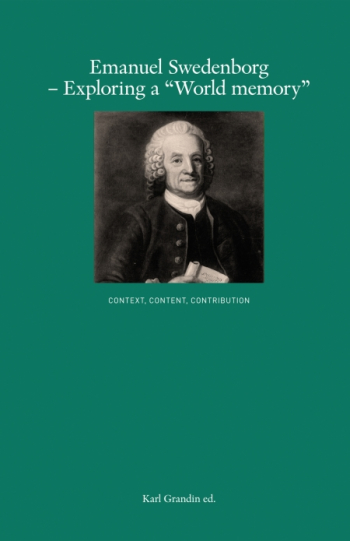
Karl Grandin, editor
Swedenborg Foundation
Softcover $44.95 (376pp)
978-0-87785-351-0
Buy: Local Bookstore (Bookshop), Amazon
At the height of the Enlightenment, well into his mid fifties, one of Europe’s more respected scientific minds—author of numerous works on chemistry, physics, algebra, metallurgy, and human anatomy— suddenly began experiencing intense spiritual dreams and, within months, was in full-scale communication with the spiritual world.
This mother of all midlife crises prompted Emanuel Swedenborg to petition his king to be released from service on the Board of Mines so that he could publish some of religious history’s most provocative ideas on heaven, hell, angels, Jesus, devils, life on other planets, and so much more. These titles—Secrets of Heaven, Heaven and Hell, Divine Love and Wisdom, Divine Providence, and True Christianity—influenced William Blake, Samuel Taylor Coleridge, Yeats, Emerson, Henry and William James, and Zen author D. T. Suzuki, among untold others.
In 1849, the Pennsylvania-based Swedenborg Foundation was organized to “foster an affirmative, informed, and increasingly broad engagement with the spiritual experiences and theological works” of the man, including the publishing of books, translations, and the hosting of conferences. In 2010, one such scholarly conference was held at the Swedish Royal Academy of Sciences in Stockholm. Attracting Swedenborg scholars from around the world, submitted papers discussed three categories—Context, Content, and Contribution—the full breadth of which were recently compiled into Emanuel Swedenborg—Exploring a “World Memory.“
As both an introductory and insightful scholarly work, the book provides a superb compendium of Swedenborg’s life and influence.
MATT SUTHERLAND (August 31, 2013)
Matt Sutherland


